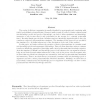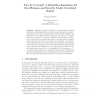281 search results - page 40 / 57 » Non-black-box Techniques in Cryptography |
STOC
2005
ACM
14 years 10 months ago
2005
ACM
Assume that Alice and Bob, given an authentic channel, have a protocol where they end up with a bit SA and SB, respectively, such that with probability 1+ 2 these bits are equal. ...
STOC
2002
ACM
14 years 10 months ago
2002
ACM
The notion of efficient computation is usually identified in cryptography and complexity with (strict) probabilistic polynomial time. However, until recently, in order to obtain c...
ICCD
2007
IEEE
14 years 6 months ago
2007
IEEE
Building fully synchronous VLSI circuits is becoming less viable as circuit geometries evolve. However, before the adoption of purely asynchronous strategies in VLSI design, globa...
TCC
2010
Springer
14 years 6 months ago
2010
Springer
A family of trapdoor functions is one-way under correlated inputs if no efficient adversary can invert it even when given the value of the function on multiple correlated inputs. T...
TCC
2010
Springer
14 years 6 months ago
2010
Springer
Goldreich-Krawczyk (Siam J of Comp’96) showed that only languages in BPP have constant-round public-coin black-box zero-knowledge protocols. We extend their lower bound to “ful...


